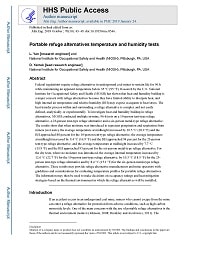Mining Publication: Portable Refuge Alternatives Temperature and Humidity Tests
Original creation date: October 2018
Authors: L Yan, D Yantek
Federal regulations require refuge alternatives in underground coal mines to sustain life for 96 h while maintaining an apparent temperature below 35 °C (95 °F). Research by the U.S. National Institute for Occupational Safety and Health (NIOSH) has shown that heat and humidity buildup is a major concern with refuge alternatives because they have limited ability to dissipate heat, and high internal air temperature and relative humidity (RH) may expose occupants to heat stress. The heat transfer process within and surrounding a refuge alternative is complex and not easily defined, analytically or experimentally. To investigate heat and humidity buildup in refuge alternatives, NIOSH conducted multiple in-mine, 96-h tests on a 10-person tent-type refuge alternative, a 23-person tent-type refuge alternative and a six-person metal-type refuge alternative. The results show that when moisture was introduced to represent perspiration and respiration from miners (wet tests), the average temperature at midheight increased by 10.5 °C (18.9 °F) and the RH approached 88 percent for the 10-person tent-type refuge alternative; the average temperature at midheight increased by 9.4 °C (16.9 °F) and the RH approached 94 percent for the 23-person tent-type refuge alternative; and the average temperature at midheight increased by 7.7 °C (13.9 °F) and the RH approached 95 percent for the six-person metal-type refuge alternative. For the dry tests, where no moisture was introduced, the average internal temperature increased by 12.6 °C (22.7 °F) for the 10-person tent-type refuge alternative, by 10.3 °C (18.5 °F) for the 23-person tent-type refuge alternative and by 8.4 °C (15.1 °F) for the six-person metal-type refuge alternative. These results may provide refuge alternative manufacturers and mine operators with guidelines and considerations for evaluating temperature profiles for portable refuge alternatives. The information may then be used to make decisions on occupancy ratings and heat mitigation strategies based on the thermal environment in which the refuge alternatives will be installed.

- Analysis of Heat Loss Mechanisms for Mobile Tent-Type Refuge Alternatives
- Announcing Two New Sister Publications on Refuge Alternatives
- Development of Heat Mitigation Systems for Refuge Alternatives used in Underground Coal Mines
- Effects of Mine Strata Thermal Behavior and Mine Initial Temperatures on Mobile Refuge Alternative Temperature
- Estimation of Metabolic Heat Input for Refuge Alternative Thermal Testing and Simulation
- Investigation of Temperature Rise in Mobile Refuge Alternatives
- NIOSH Refuge Alternative Webinar
- RA Heat Mitigation System Utilizing Advanced Liquid Air Technologies
- Temperature Rise Within a Mobile Refuge Alternative (RA) - Experimental Investigation and Model Validation
- Validation of Temperature and Humidity Thermal Model of 23-person Tent-type Refuge Alternative